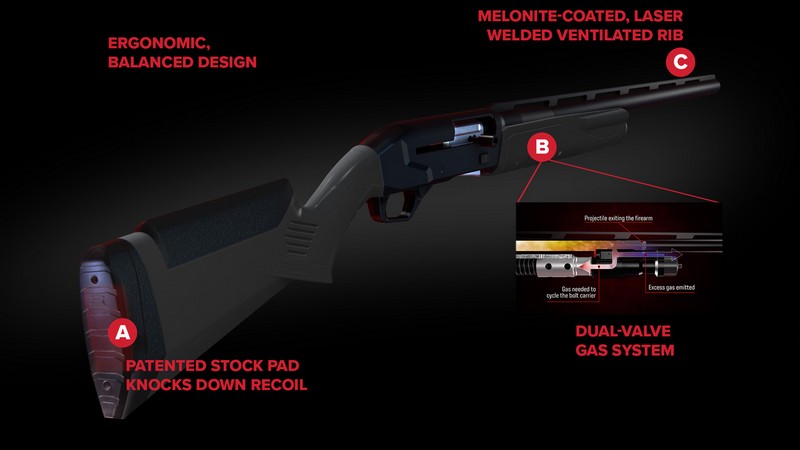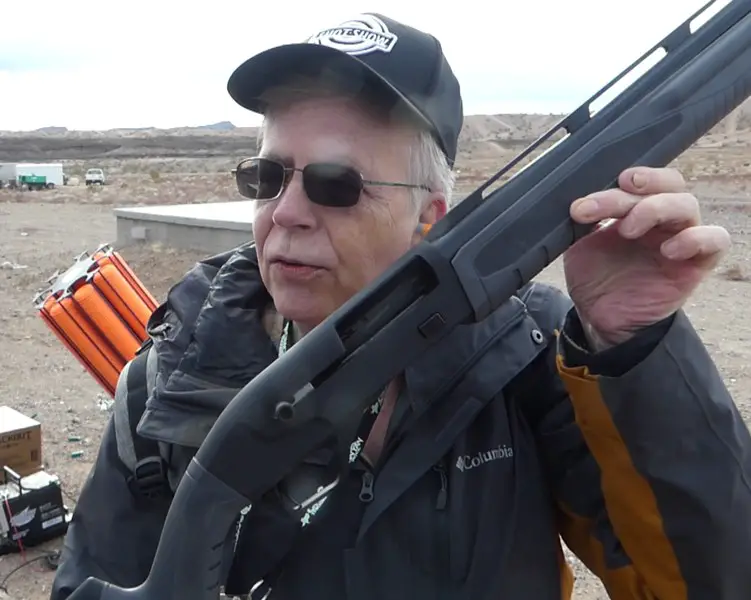Savage Arms announces . . . the Renegauge Autoloading Shotgun

57602 / RENEGAUGE, 12 Gauge Black Synthetic 28-inch barrel / $1,449
57603 / RENEGAUGE, 12 Gauge Black Synthetic 26-inch barrel / $1,449
57604 / RENEGAUGE Waterfowl, 12 Gauge Mossy Oak Shadow Grass Blades 28-inch barrel / $1,549 57605 / RENEGAUGE Waterfowl, 12 Gauge Mossy Oak Shadow Grass Blades 26-inch barrel / $1,549 57606 / RENEGAUGE TURKEY, 12 Gauge Mossy Oak Bottomland 24-inch barrel / $1,549
57607 / RENEGAUGE TURKEY, 12 Gauge Mossy Oak Obsession 24-inch barrel / $1,549
Of course, manufacturer's suggested retail prices don't mean much. I'll speculate that the base model of the Renegauge will run in the $1100 - $1200 area street price, or even a tad less. Since I have neither seen a Renegauge, much less shot one, I can't tell you how well it functions.
Al Kasper, President of Savage, has been quoted as saying he “killed the project three times because the cost was too high and the gun was too heavy.” Apparently, the Renegauge has been under development on and off for the last seven years. A lot has happened with Savage, for Savage was part of Vista Outdoors group until fairly recently, but now Savage is Savage again, purchased from Vista Outdoors by an investment group led by Al Kasper.
Although called Savage's “first” semi-auto shotgun, that is hardly the case. Savage made their long-recoil Model 720 from 1930-1949, their model 775 between 1949 and 1958, the Model 775 between 1950 and 1966, and the Model 750 from 1960-1967. It has been a while, though.
Savage has applied their successful Accu-Fit system from their rifles (adjustable length of pull, adjustable comb risers) to the Renegauge, so you get three interchangeable gel comb inserts, along with shims to adjust cast and drop with the shotgun, and three interchangeable recoil pads to adjust length of pull. With three recoil pads and three combs included right in the box, the Renegauge has the potential to fit more shooters than most any repeating shotgun with no gunsmithing required.
Although Savage says they have fluted the barrel (fluting makes no sense to me on a shotgun barrel) and reduced the weight by 10%, it is still a heavy gun, running from 7.75 lbs. for the 24 inch turkey models to 8.0 pounds to the 28 inch waterfowler. Some of the Savage blurbs call the gun “lightweight and efficient.” Well, lightweight it clearly is not, nor would that be expected with a steel receiver. As a heavy gas-operated semi-auto, I would expect it to be extremely soft-shooting. We will see.
The
turkey models are a bit odd, as I see no mention of a tapped and
drilled receiver for optics, nor are there any rifle-sighted models
(or barrels). My favorite turkey shotguns have rifle sights, which
makes it effortlessly easy. Maybe the receiver is drilled and tapped
for a base, but if it isn't that's a huge oversight.
The Melonite-treated barrel is an excellent addition, particularly for a waterfowl gun. There is Melonite Q, QP, and Melonite QPQ. QPQ has better corrosion resistance than hard chrome, double chrome, or nickel plating, although Savage is not specific about what Melonite process is used.
Savage claims the Renegauge is extremely fast cycling, but so do a lot of folks. The Fabarm XLR5 Waterfowler is the "fastest cycling semi-auto hunting gun on the planet at .31 of a second for five rounds". Various other shotguns are claimed to be the fastest as well (A400, SX-3, etc.) are just fast. They are all more than fast enough for wingshooting purposes, as far as I'm concerned.
It is a heavy gun, too heavy to pleasantly hunt wild pheasants, but then again . . . when I was shooting doves in Argentina, I used a steel-receiver B-80. I still have that shotgun, and . . . it weighs 8 lbs. The weight of the Savage Renegauge is off-putting if you are walking a lot, but in the duck blind, goose pit, turkey blind, for casual clays, or banging away on the dove field . . . weight isn't that much of a factor. I'm not convinced that the fluted barrel shaves that much weight, not as much as a “technopolymer” (sometimes called carbon fiber) rib would do, but that's the path Savage took. The wall thicknesses of my 12 gauge shotguns are already thin to the point where there is nothing to possibly flute. I must be missing something?
For many years, Savage (with the exception of their slug guns) has done what Weatherby, TriStar, and many others have done: find a manufacturer somewhere in Turkey, China, Brazil, or the Philippines ... put it in a box with their name on it, and call it good. Smith & Wesson and Ruger have left the shotgun market altogether.
It is a big jump for Al Kasper and Savage to invest in all-new tooling for all-new parts for an all-new shotgun made in Westfield, Mass., USA. Aside from Remington, no one has developed and put to market an all-new autoloading action in many, many years. Inertia guns are from the 1960s, the Browning "Active Valve" gas guns are from the early 1990s, and so it goes. The A400 is a variation of the Beretta Xtrema 391 from 2002. The Benelli M4 that Beretta / Benelli did nothing with for the hunting or clays market is from 1998.
Surely Al Kasper and his team are convinced of the value and sale-ability of the Renegauge. It would have been far cheaper and far easier to just do nothing. A lot easier. Who knows, the Renegauge might be the world's most comfortable shotgun to shoot in the duck blind? We will have to see.
The usual questions, how easy it loads / unloads, how well it is balanced, how good is the trigger, how many rounds before cleaning, whether it is a “picky eater” (or not) and so forth, can't be answered until my test example arrives. The great value of the Renegauge lies in the Savage Accu-fit system of the included three gel combs and three recoil pads in addition to the supplied cast and drop shims. To the extent the Renegauge fits you better than anything else, with no gunsmithing or pricey stock work, is the ticket that just might turn this shotgun into the best overall deal for you out there.
I was told by Savage that the Renegauge is not in production yet, but is scheduled to go into production this month (January 2020). Availability is guessed at March / April.
1/24/2020 UPDATE

After inspecting and shooting a 26 inch example in Las Vegas, I found the gun to be annoyingly front heavy, far too heavy in general (8 lbs. approximately), and remarkably ugly. Savage claims to reduce the weight of the gun by 10% with the barrel fluting, a claim that is just absurd. There were no functional issues noted, however. It is a soft-shooting gun, but I've never fired an 8 lb. gas semi-auto that wasn't.
The "turkey gun" is anything but, lacking a drilled / tapped receiver for optics, or any iron sights. It is merely the same 26 or 28 inch Renegauge with a 24 inch barrel. I mentioned this directly, out loud in front of God and everyone. I was told that 'potentially in the future' you may be able to buy a barrel with a cantilevered mount for it. It makes no sense to me to call this a turkey gun. With this novel theory, any plastic-stocked semi-auto with a 24 inch barrel is somehow a "dedicated turkey gun." It is merely a barrel length option, not a new model or configuration of shotgun.

The $1549 Renegauge Turkey is a really hard sell (if not an impossible sell) compared to the $1195 MSRP Remington V3 Turkey Pro that includes a Picatinny rail and a bore-sighted, pre-installed Truglo optic, shown above.

The "Turkey Gun" model is even more puzzling, considering that Savage already has two outstandingly good Accu-Fit turkey guns in both 12 and 20 gauge, the 212 Turkey and the 220 Turkey (above) both with 22 inch barrels. The MSRP on the 220 Turkey is $695.
Things may change, as this was not an actual production gun. When Savage CEO Al Kasper previously killed this project three times because "the cost was too high and the gun was too heavy" I'm left with the impression that he should have chambered a fourth round . . . and swiftly killed it again.
Copyright 2020 by Randy Wakeman. All Rights Reserved.











